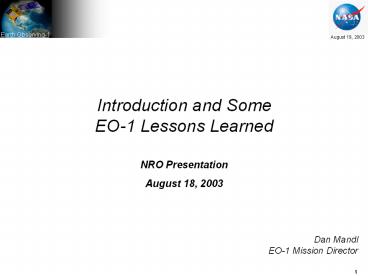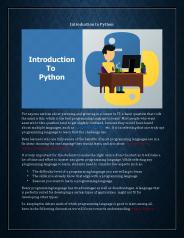Introduction and Some EO-1 Lessons Learned - PowerPoint PPT Presentation
1 / 18
Title:
Introduction and Some EO-1 Lessons Learned
Description:
EO-1 Lessons Learned NRO Presentation August 18, 2003 Dan Mandl EO-1 Mission Director Agenda Overview of technology validation missions Overview of EO-1 ... – PowerPoint PPT presentation
Number of Views:25
Avg rating:3.0/5.0
Title: Introduction and Some EO-1 Lessons Learned
1
Introduction and SomeEO-1 Lessons Learned
- NRO Presentation
- August 18, 2003
Dan MandlEO-1 Mission Director
2
Agenda
- Overview of technology validation missions
- Overview of EO-1 Mission
- Mission phases
- Continuous improvement efforts
- Some lessons learned
3
Technology Validation Missions
- A mission designed to flight validate new
technologies to lower the cost or improve the
performance of a future mission - At NASA, the future missions are all science
missions but this is not a requirement for the
process - The NASA New Millennium Program (NMP) is
responsible for the flight validation of new
technologies relevant to future science missions
in both the Office of Space Science and the
Office of Earth Science - Within the NMP, each technology has a Validation
Plan consisting of two components - Technical Validation technologists and
engineers proving the technology works in space
as advertised - Science Validation scientists proving the
technology is capable of doing the science for
which it is intended
4
Technology Validation Missions
5
Mission Overview
- Validate revolutionary technologies contributing
to the reduction of cost and increased
capabilities for future land imaging missions - Revolutionary land imaging instruments on EO-1
- Hyperion
- Advanced Land Imager (ALI)
- Atmospheric Corrector (AC)
- Revolutionary Spacecraft technologies on EO-1
- X Band Phased Array Antenna (XPAA)
- Pulse Plasma Thruster (PPT)
- Light Weight Flexible Solar Array (LFSA)
- More on website eo1.gsfc.nasa.gov
- Carbon-Carbon Radiator (CCR)
- Enhanced Formation Flying (EFF)
Mission Overview
6
EO-1 Mission Phases
- After base mission, three more mission phases
evolved as depicted in chart below - Sensor Web/Testbed phase is active now
- Virtual observatory phase is the phase in which
as much mission autonomy as possible will be
implemented to reduce the cost as much as
possible of running the EO-1 mission - Includes semi-autonomous tasking of EO-1
Phase 1
Accelerated Mission
Phase 2
Public Access
Phase 3
Sensor Web/Test-Bed
Phase 4
Virtual Observatory
Baseline Mission
Extended Mission
Launch
Q4
Q1
Q2
Q3
Q4
Q1
Q2
Q3
Q4
Q1
Q2
Q3
Q4
Q1 Q2 Q3
2000
2002
2004
2003
2001
7
Sorting Success Criteria for EO-1 Pre-Launch
8
Determining EO-1 S/C Total Reliability Over
Mission Life
9
How S/C Reliability Was Determined
10
Mission Redesign as a Result of Success Criteria
and Reliability Assessment
11
Budget Realignment to Support Redesigned
Accelerated Mission
12
Continuous Improvement Efforts to Lower Imaging
Costs
13
Testing Sensor Web Concepts Using EO-1 as a
Testbed
Operational Testbed
Autonomous Coordination
End-to-End Communications
On-board Processing
On-board Cloud Cover Detection Validation
- Autonomous Science Experiment(ASE)
- Migration of ST6 onto EO-1
- Preliminary EO-1 Autonomy Experiment
- On-board planning
- On-board feature detection
- Dynamic SW Bus
- EO-1, Terra, Aqua SensorWeb Demo 1 2
- Uses MODIS inst center to detect volcanoes
- Uses ASE to coord image collect autonomously
- SensorWeb Testbed
- Test SensorWeb concepts on ground
- Smart Antenna
- Ground phased array
- Cell tower com to sat
- EO-1/ Gnd Sensor SensorWeb
- Sensors in Huntington Botanical Garden trigger
EO-1 image
- Hyperspectral Compression WG
- On-board data mining
- On-board intelligent image compression
- Working group
- Livingstone On-board Model Based Diag Tool
- Autonomous anomaly diagnosis and recommendations
Intelligent Distributed Spacecraft Technology
Testbed
Funded by ESTO
Funded by NMP
Funded by RASC
Proposed activity
14
Sample Science Goal Monitor User page
Experiment for Virtual Observatory Front End
15
Lessons Learned (1 of 4)
- When compared to small science missions, EO-1 was
inherently risky since it is a Technology
Validation mission due to - Maturing the technologies
- Architectural risks
- Developing the technologies
- Flight-validating the technologies
- Infusing the technologies
- Mitigating these risks required
- Greater reserves of time and money
- More capable people throughout the Project
- Robust Risk Management from the beginning
- Strong System Engineering is ABSOLUTELY ESSENTIAL
in orchestrating a successful Technology
Validation mission - Ready and repeated access to the best engineering
talent is required a deep bench of
engineering talent
16
Lessons Learned (2 of 4)
- More specific Lessons Learned from the NMP/EO-1
mission - Insist on thorough documentation of all vendor
(subcontractor) tests. - Document the as-built characteristics of each
part. - Provide a complete photo documentation of the
instrument prior to delivery, with close-ups of
all critical items. - Comparison of several independent calibration
techniques has proved to be extremely valuable
both in ground and on-orbit measurements. - Calibration of each detector of a large focal
plane is a manageable job but requires thorough
preparation of test plans, test instrumentation
and associated software to process the resulting
large volume of data.
17
Lessons Learned (3 of 4)
- Pre-Launch Design for flexibility
- Build organization for flexibility
- Requirements change inflexibility costs
additional money in long run - Perform reliability assessment using FMEA and
fault trees - Design S/C with selective redundancy based on
risk/reliability assessment - Overstaff operations to provide risk buffer
- Easier to de-staff than to gain expertise quickly
- FOT used to augment IT and as workarounds to
other problems found on S/C - Use contractual mechanisms that allow flexibility
in obtaining additional staff as needs arise
there is always turnover - Facilities should be expandable and changeable to
the degree possible to accommodate requirements
changes
18
Lessons Leaned (4 of 4)
- Pre-Launch Post-Launch Design for flexibility
- Build Continuous Improvement Program from day one
- Build capability in mission for progressive
autonomy - Many mission lessons learned occur shortly before
launch and during early operations - Need capability to install autonomy as operations
staff learns how mission needs to run





























